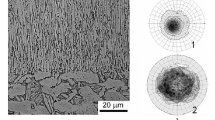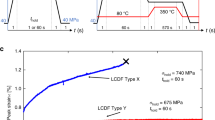Abstract
The dwell effect of the material can reduce the fatigue lives of titanium alloys at room temperature. A unified fatigue life prediction method developed by the authors’ group is modified in this paper to predict dwell-fatigue crack growth taking into account the effects of dwell time and maximum stress. The modified model can be successfully used to predict the crack growth rate and calculate the fatigue life of different titanium alloys under pure fatigue and dwell-fatigue conditions. It is validated by comparing prediction results with the experimental data of several titanium alloys with different microstructures, dwell time, hydrogen contents, stress ratios and stress levels .










Similar content being viewed by others
Abbreviations
- A 1 :
-
Material and environmentally sensitive constant of dimensions in the crack growth rate model
- m 1 :
-
Constant representing the slope of the corresponding fatigue crack growth rate curve in the crack growth rate model
- △K th :
-
Threshold stress intensity factor range
- K max :
-
The maximum stress intensity factor
- K min :
-
The minimum stress intensity factor
- △K op :
-
Stress intensity factor range at the opening level
- △K effth :
-
Effective range of the stress intensity factor range at the threshold level
- K cf :
-
Fracture toughness of the material
- σ u :
-
Ultimate strength of the material
- σ y :
-
Yield strength of the material
- σ fl :
-
Flow stress of the material
- σ v :
-
Virtual strength of the material representing the material strength at limit of ‘perfect’ condition (r e = 0)
- σ max :
-
The maximum stress level
- σ min :
-
The minimum stress level
- ν :
-
Poisson’s ratio
- R :
-
Stress ratio defined by σ max/σ min
- r e :
-
Empirical material constant of the inherent flaw length of the order of 1 μm
- f op :
-
Crack opening function defined as the ratio K op /△K
- da/dN :
-
Fatigue crack growth rate
- k :
-
Material constant which reflects the rate of crack closure development with crack advance
- n 1 :
-
Index indicating the unstable fracture in the crack growth rate model
- a :
-
Crack length
- Y :
-
Geometrical factor to calculate the stress intensity factors
- α′:
-
Plane stress/strain constraint factor
- α :
-
Parameter used to calculate the ‘virtual strength’ of the material
- A 1, A 2, A 3, A 4 :
-
Coefficients defined to calculate the crack opening function f op
- △K th-cl :
-
Component of the stress intensity factor range corresponding to crack closure
- Δσ R :
-
Plain fatigue limit under stress ratioR
- d :
-
Intrinsic crack length
- △K th-s :
-
Crack propagation threshold for short fatigue crack under stress ratioR
- △K thR :
-
Threshold for long crack under the stress ratioR
- A 2, m 2, n 2 :
-
Material and environmental parameters, similar as A 1, m 1, n 1
- κ :
-
Material parameter for the influence level of the maximum stress
- t :
-
Dwell time
References
M.R. Bache, Int. J. Fatigue 25, 1079 (2003)
R. Wanhill, S. Barter, Fatigue of Beta Processed and Beta Heat-Treated Titanium Alloys (Springer, The Netherlands, 2012)
P. Lefranc, V. Doquet, M. Gerland, C. Sarrazin-Baudoux, Acta Mater. 56, 4450 (2008)
W.J. Evans, C.R. Gostelow, Metall. Trans. A 10, 1837 (1979)
W.J. Evans, M.R. Bache, Int. J. Fatigue 16, 443 (1994)
W.J. Harrison, M.T. Whittaker, R. Lancaster, Mater. Sci. Eng., A 574, 130 (2013)
F. McBagonluri, E. Akpan, C. Mercer, W. Shen, W.O. Soboyejo, Mater. Sci. Eng., A 405, 111 (2005)
W. Shen, W.O. Soboyejo, A.B.O. Soboyejo, Metall. Mater. Trans. A 35, 163 (2004)
W. Shen, W.O. Soboyejo, A.B.O. Soboyejo, Mech. Mater. 36, 117 (2004)
M.R. Bache, M. Cope, H.M. Davies, W.J. Evans, G. Harrison, Int. J. Fatigue 19, 83 (1997)
W.J. Evans, Mater. Sci. Eng., A 243, 89 (1998)
J.E. Hack, G.R. Leverant, Metall. Trans. A 13, 1729 (1982)
M.R. Bache, W.J. Evans, H.M. Davies, J. Mater. Sci. 32, 3435 (1997)
W.J. Evans, J. Mater. Sci. Lett. 6, 571 (1987)
W.J. Evans, Fatigue Fract. Eng. Mater. Struct. 27, 543 (2004)
B.R. Bache, W.J. Evans, V. Randle, R.J. Wilson, Mater. Sci. Eng., A 257, 139 (1998)
J.C. Radon, K. Nikbin, Influence of Specimen Geometry on the Random Load Fatigue Crack Growth, in: ASTM Special Technical Publication, vol. 1406, (ASTM International, PA, USA, 2001), pp. 88–104
M.R. Bache, W.J. Evans, Int. J. Fatigue 14, 331 (1992)
C.A. Stubbington, S. Pearson, Eng. Fract. Mech. 10, 723 (1978)
P. Lefranc, C. Sarrazin-Baudoux, V. Doquet, Dwell-fatigue behaviour of a beta-forged Ti 6242 alloy, in Fracture of Nano and Engineering Materials and Structures, ed. by E.E. Gdoutos (Springer, The Netherlands, 2006), pp. 171–172
P. Lefranc, C. Sarrazin-Baudoux, V. Doquet, J. Petit, Scr. Mater. 60, 281 (2009)
M. Gerland, P. Lefranc, V. Doquet, C. Sarrazin-Baudoux, Mater. Sci. Eng., A 507, 132 (2009)
P. Lefranc, C. Sarrazin-Baudoux, M. Gerland, V. Doquet, J. Petit, Dwell-fatigue behavior of a near Alpha-Ti 6242 alloy, Paper presented at the 17th European Conference on Fracture: Multilevel Approach to Fracture of Materials, Components and Structures, Brno, Czech Republic, 2–5 September 2008
W.C. Cui, X.P. Huang, Acta. Metall. Sin. (Engl. Lett.) 16, 342 (2003)
X.Y. Li, W.C. Cui, W.M. Zhang, J. Ship Mech. 10, 54 (2006)
Y.F. Wang, W.C. Cui, X.Y. Wu, F. Wang, X.P. Huang, Int. J. Fatigue 30, 1851 (2008)
A.J. McEvily, Y.S. Shin, J. Eng. Mater. Technol. 117, 408 (1995)
S. Pearson, Eng. Fract. Mech. 7, 235 (1975)
S. Suresh, R.O. Ritchie, Int. Met. Rev. 29, 445 (1984)
J. Lankford, Int. J. Fract. 16, R7 (1980)
O.N. Romaniv, V.N. Simin’kovich, A.N. Tkach, Mater. Sci. 18, 234 (1982)
K. Tanaka, Y. Nakai, M. Yamashita, Int. J. Fract. 17, 519 (1981)
K. Tanaka, M. Hojo, Y. Nakai. Mater. Sci. Eng. 55, 85 (1982)
D.L. Chen, B. Weiss, R. Stickler, Int. J. Fatigue 16, 485 (1994)
C. Santus, D. Taylor, Int. J. Fatigue 31, 1356 (2009)
A.J. McEvily, Mater. Sci. Eng., A 143, 127 (1991)
A.J. McEvily, K. Minakawa, Scr. Metall. 18, 71 (1984)
A.J. McEvily, Key Eng. Mater. 510, 15 (2012)
D.S. Dugdale, J. Mech. Phys. Solids 8, 100 (1960)
M.D. Chapetti, Int. J. Fatigue 25, 1319 (2003)
D. Munz, V. Bachmann, Z Werkstofftech. J. Mater. Technol. 11, 168 (1980)
R.P. Wei, Z. Huang, Mater. Sci. Eng., A 336, 209 (2002)
T. Wakai, C. Poussard, B. Drubay, Nucl. Eng. Des. 224, 245 (2003)
A. Saxena, Fatigue Fract. Eng. Mater. Struct. 3, 247 (1980)
K.X. Shi, F.S. Lin, J. Chin. Soc. Power Eng. 30, 304 (2010). (in Chinese)
P. Wang, J.X. Dong, M.C. Zhang, L. Zheng, X.S. Xie, Rare Met. Mater. Eng. 40, 630 (2011). (in Chinese)
Acknowledgments
This work was financially supported by Youth Foundation of Jiangsu Province “Study on the time-scale crack growth rate model used in fatigue life assessment of pressure hull of deep-sea submersibles” (No. BK2012095), the National Natural Science Foundation of China (Nos. 51109100 and 51439004), the National Natural Science Foundation for Young Scholars of China (No. E091002/51109101) and the Shanghai Committee of Science and Technology Projects (Nos. 14DZ1205500 and 14DZ2250900).
Author information
Authors and Affiliations
Corresponding author
Additional information
Available online at http://link.springer.com/journal/40195
Rights and permissions
About this article
Cite this article
Wang, K., Wang, F., Cui, WC. et al. Prediction of Cold Dwell-Fatigue Crack Growth of Titanium Alloys. Acta Metall. Sin. (Engl. Lett.) 28, 619–627 (2015). https://doi.org/10.1007/s40195-015-0240-x
Received:
Revised:
Published:
Issue Date:
DOI: https://doi.org/10.1007/s40195-015-0240-x




